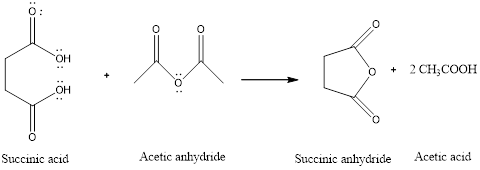
(a)
Interpretation:
To propose a mechanism for the formation of succinic anhydride in the presence of acetic anhydride and how acetic anhydride makes it easier to form the succinic anhydride.
Concept introduction:
Succinic anhydride is a type of cyclic anhydride formed by the dehydration of dicarboxylic acid that is succinic acid. The cyclic anhydride is formed easily in the presence of anhydride such as acetic anhydride.
The reaction is:

(b)
Interpretation:
To propose a mechanism for the formation of succinic anhydride in the presence of acetic anhydride and how acetic anhydride makes it easier to form the succinic anhydride.
Concept introduction:
Succinic anhydride is a type of cyclic anhydride formed by the dehydration of dicarboxylic acid that is succinic acid. The cyclic anhydride is formed easily in the presence of anhydride such as acetic anhydride.
The reaction is:

Want to see the full answer?
Check out a sample textbook solution
Chapter 15 Solutions
Organic Chemistry Study Guide and Solutions Manual, Books a la Carte Edition (8th Edition)
- How many products are possible from the following reaction? Do not take into account stereoisomers. 01 04 03 O O O O 02 CH H₂SO4 heatarrow_forwardplease helparrow_forwardChoose the major product of the reaction with correct regio- and stereochemistry. Br2 H₂O O "Br Br & O 'Br OH Br 吡 O OH OH Br "OH Brarrow_forward
- Select the major product of the following reaction. & Br (CH)CONa (CH₂),COH 0 OC(CH) O &arrow_forwardDraw the products of the hydrolysis reaction between the ester molecule and water. Determine the products of the following reaction.arrow_forwardWhat is the unsaturation number for compounds with the formula C₂H₁₂Cl₂? O õ õ o o 4 3arrow_forward
- Indicate the product obtained (formula). F3C. CF3 Br NH2 NH OMe K2CO3, DABCO, DMFarrow_forwardWhat are the missing intermediates 1, 2, and 3? Please include a detailed explanation explaining the steps of malonic ester synthesis. Please include drawings of the intermediates and how they occur.arrow_forwardThe following intermediates are to proceed by acetoacetic ester synthesis. What are intermediates 1 and 2 plus the final product 3? Please include a detailed explanation and drawings of the intermediates and how they occurred.arrow_forward

 Chemistry for Today: General, Organic, and Bioche...ChemistryISBN:9781305960060Author:Spencer L. Seager, Michael R. Slabaugh, Maren S. HansenPublisher:Cengage Learning
Chemistry for Today: General, Organic, and Bioche...ChemistryISBN:9781305960060Author:Spencer L. Seager, Michael R. Slabaugh, Maren S. HansenPublisher:Cengage Learning Organic Chemistry: A Guided InquiryChemistryISBN:9780618974122Author:Andrei StraumanisPublisher:Cengage Learning
Organic Chemistry: A Guided InquiryChemistryISBN:9780618974122Author:Andrei StraumanisPublisher:Cengage Learning


